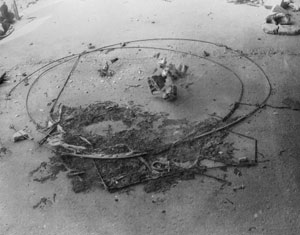12.8.23 — Finding One’s Place
Immigration keeps making headlines—and making art. Sheida Soleimani in Tribeca and, before her, Daniel Shieh on Governors Island could not stop thinking about their parents and rites of passage to the United States. But the voices in their head keep multiplying, and Shieh is still singing the national anthem.
Now immigration is only the first story in “Immersion,” where Raymond Meeks, Vasantha Yogananthan, and Gregory Halpern look to photography for a sense of place, at the International Center of Photography through January 8. 
ICP can hardly avoid taking immigration as a fact of life, apart from “Immersion.” With some two hundred fifty photographs of Marlene Dietrich on loan from Pierre Passebon, it features an actress who fled the Nazis in 1930, the very year of The Blue Angel, and contributed what she could to her adopted country, from the movies to the USO. With so rabid a fan and collector behind the show, it cannot help attributing the work of Hollywood’s top photographers and directors to her, her “personal wardrobe,” and “signature lighting.” Still, she is only one of those behind the film stills, publicity stills, and shots on set—and who can be confident telling them apart? A floor below Dietrich, Muriel Hasbun has made her way from El Salvador to France and, ultimately, the District of Columbia. Along with her complicated history, she is describing a supremely blended family, as I explain separately.
As for “Immersion,” could there be more to immigration than makes the news? One could almost forget the families lining up for Ellis Island to this day—not for admission to this country, but to claim it as their heritage. When Meeks tells of immigration to France, he is not speaking about boat people from Africa and risks of death. He is tracing the passage from the First World, from the United Kingdom and Spain, without an immigrant in sight. All photographs are traces, of chemicals in response to light. Meeks, though, finds the traces of humanity in where it trod.
He sees immigration as a kind of earthworks, from a circle of branches to rocks rising like totems from the sea. Craggy cliffs must have offered handholds but tough going. Still, traces have by definition faded and given way, and these look more faint than formidable. It can seem like cheating not to mention the fate of those who made the crossing or the reception they received, of hatred or welcome. It humanizes a political debate all the same. It also finds an alternative definition of the “real” France, not in a language and culture, but in the changing earth.
ICP introduces all three photographers as constructing a sense of place, not just in where they worked, but in their collected work as installation. Each has a room to himself, and individual photos vary greatly in size and in how they hang. Yogananthan shoots black children at play in New Orleans, just past the age of innocence. Taken together, the photos could suggest a playground. And yet they have no obvious object or rules of the game. The intensity of daylight or of shadows at dusk is itself way too strong for just playing around.
Halpern adds sculpture, a bust atop a short pillar with a cinder block and steel at its base. He needs it to give Guadeloupe a history. It is the bust of Christopher Columbus, erected by French administrators in 1915, while photos look back to the imprisonment of slaves and the abolition of slavery. It is not, though, a linear or progressive history. The bust finds its echoes in the mask that a young woman holds just apart from her face. Text on slavery appears in a tattoo, because that, too, has left its traces.
I am not convinced that I am seeing installations. I am not certain, for that matter, of a shared sense of politics and place. Yet I know it matters, and each country deserves a history all its own. So does each photographer. In context, they also have a collective message. A native’s or immigrant’s tale does not begin or end with birth or immigration.
Read more, now in a feature-length article on this site.